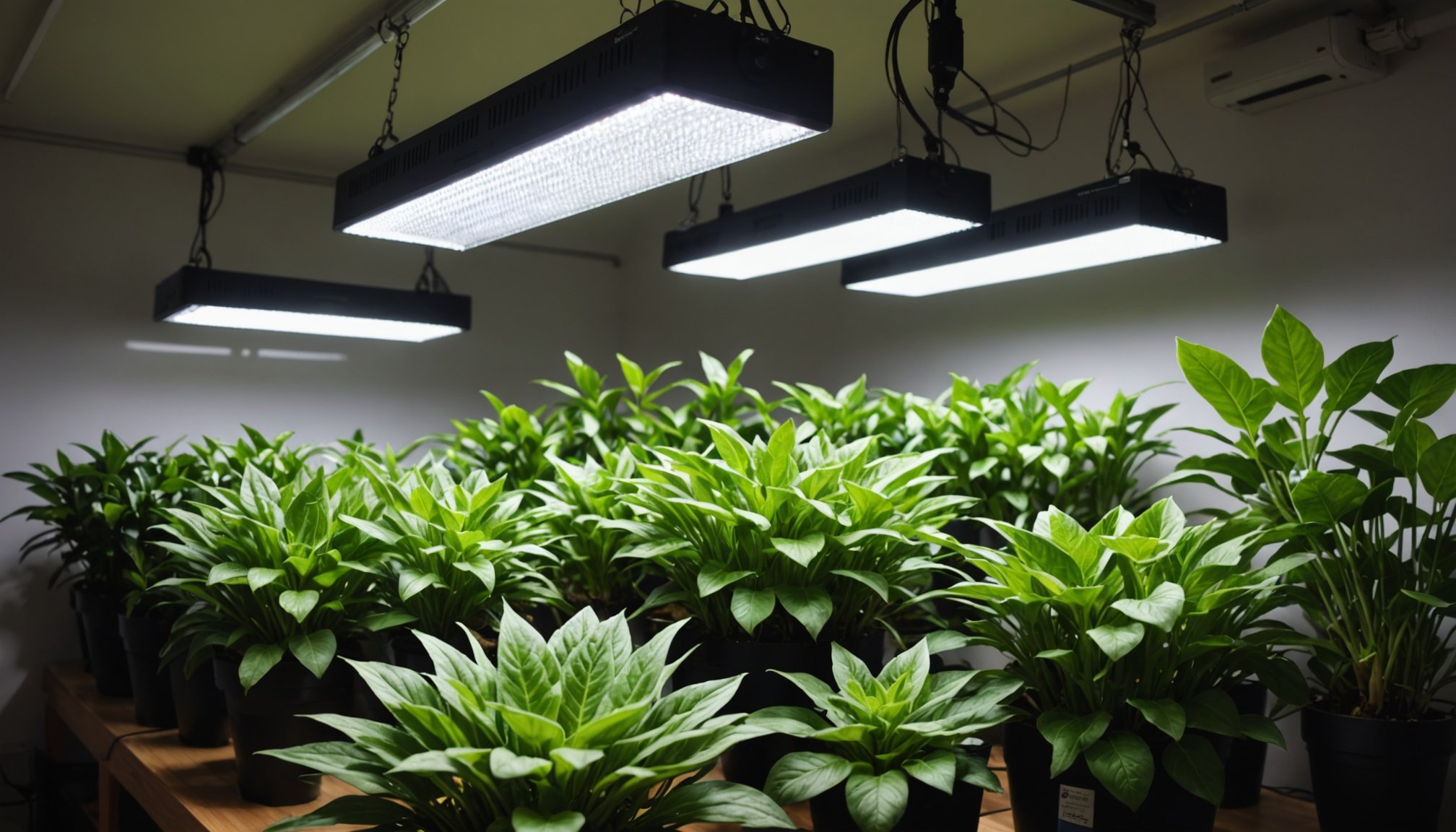Indoor gardening offers a unique opportunity to enhance your living space, yet controlling growth conditions is often a challenge. LED grow lights may provide the ideal solution for plant enthusiasts in the UK, promoting healthier and more vibrant indoor greenery. This guide explores how these lights function and their potential to revolutionise your home gardening experience. Discover the benefits of incorporating LED technology, ensuring your plants thrive throughout the year, regardless of natural light limitations.
Understanding LED Grow Lights
LED grow lights have revolutionised indoor gardening by providing efficient and effective lighting solutions for plant growth. These lights use LED technology, which stands for Light Emitting Diodes, to emit light that plants can use for photosynthesis. Unlike traditional lighting options, such as fluorescent or incandescent bulbs, LED grow lights are designed to mimic the natural sunlight spectrum more closely, which is crucial for optimal plant development.
Dans le meme genre : Transform Your East Anglian Garden: Expert Tips for Crafting a Drought-Resilient Landscape
One of the key advantages of LED grow lights over traditional lighting is their energy efficiency. They consume less electricity, generate less heat, and have a longer lifespan, making them a cost-effective choice for indoor gardening enthusiasts. Moreover, LED grow lights can be customised to emit specific wavelengths of light, which is vital for different stages of plant growth.
The light spectrum plays a significant role in plant growth, influencing processes like germination, flowering, and fruiting. LED grow lights can be tailored to provide the exact spectrum needed for each stage, enhancing plant health and yield. This flexibility is something traditional lighting options cannot offer, making LED grow lights a superior choice for indoor gardening.
En parallèle : Transforming Your Urban UK Garden: Innovative Ways to Achieve Privacy Without Fences
Benefits of Using LED Grow Lights
LED grow lights offer several advantages that make them an ideal choice for indoor gardening. One of the primary benefits is their energy efficiency. These lights consume significantly less electricity compared to traditional lighting options, resulting in substantial cost savings for gardeners over time. This efficiency does not compromise their effectiveness; instead, it enhances it by directing more usable light to plants.
Another advantage is the positive impact on plant health. LED grow lights can be customised to emit specific wavelengths that cater to different growth stages, such as germination, flowering, and fruiting. This targeted light spectrum promotes healthier plants and faster growth rates, ensuring that each plant receives the optimal light it needs.
Moreover, LED grow lights produce considerably less heat than incandescent or fluorescent bulbs. This reduced heat output is crucial for indoor gardening, as it minimises the risk of overheating plants and allows for closer placement of lights to the plants. This proximity enhances light absorption and maximises growth potential without causing thermal stress. Overall, the combination of energy efficiency, improved plant health, and reduced heat output underscores the superiority of LED grow lights in indoor gardening.
Scientific Evidence Supporting LED Grow Light Efficacy
Numerous LED grow lights studies have demonstrated their effectiveness in enhancing plant growth. Scientific analysis shows that these lights can be tailored to provide specific light spectrums, which is essential for different plant species. For instance, research indicates that red and blue wavelengths significantly boost photosynthetic activity, leading to improved growth rates.
A key study conducted by a plant growth research team found that LED grow lights increased the yield of tomato plants by up to 20% compared to traditional lighting. This study highlights the importance of selecting the right light spectrum for optimal results. Another scientific analysis focused on lettuce, revealing that LED lights accelerated growth and improved leaf quality.
Testimonials from UK indoor gardeners further support these findings. Many have reported substantial improvements in plant health and yield after switching to LED grow lights. These gardeners emphasise the benefits of customisable light spectrums, which allow them to cater to the specific needs of various plants throughout their growth stages.
Overall, the combination of scientific research and real-world experiences underscores the efficacy of LED grow lights in promoting robust plant growth.
Choosing the Right LED Grow Lights
When selecting LED grow lights for your indoor garden, several factors should be considered to ensure optimal plant growth. Understanding the lighting specifications is crucial in making an informed decision.
Factors to Consider
-
Wattage: This indicates the power consumption of the light. While higher wattage often means more light output, it's essential to match the wattage to your indoor plant needs to avoid energy wastage.
-
Lumens: This measures the brightness of the light. Higher lumens are generally better for plants that require more intense light, like tomatoes or peppers.
-
Light Spectrum: Different plants require different spectrums at various growth stages. For instance, a blue spectrum is ideal for vegetative growth, while red is crucial for flowering and fruiting.
Recommendations
For leafy greens like lettuce or spinach, opt for LED grow lights with higher blue spectrum output. For flowering plants, ensure your lights provide a robust red spectrum. It's also wise to choose lights with adjustable spectrums to cater to the changing needs of your plants. Understanding these specifications helps tailor the lighting to your specific indoor plant needs, ensuring healthy and productive growth.
Practical Applications of LED Grow Lights in UK Homes
In the realm of indoor gardening UK, LED grow lights have become indispensable for cultivating a variety of plants. To maximise their potential, understanding the practical uses of grow lights is essential.
Best Practices for Small Spaces
For those with limited space, setting up LED grow lights efficiently is crucial. Opt for compact, adjustable fixtures that can be easily positioned. Mounting lights on shelves or using hanging systems allows for optimal light distribution without cluttering the area.
Positioning and Timing Light Exposure
Proper positioning is vital for effective indoor plant care. Place lights approximately 12 to 18 inches above plants, adjusting based on their growth stage. Ensure even coverage by rotating plants regularly. Timing is equally important; most indoor plants thrive with 12 to 16 hours of light daily. Utilising timers ensures consistent exposure, promoting healthy growth.
Beneficial Indoor Plants
LED grow lights benefit a wide range of indoor plants. Common choices include herbs like basil and mint, which flourish under consistent light. Leafy greens such as lettuce and spinach also thrive with adequate exposure. For flowering plants, orchids and African violets respond well to tailored light spectrums, enhancing bloom quality.
Climate Considerations for Indoor Gardening in the UK
Indoor gardening in the UK presents unique challenges due to the country's variable climate. The UK climate is characterised by frequent overcast skies and shorter daylight hours, especially in winter, which can affect indoor plant growth. These conditions necessitate strategic adjustments in lighting and plant care to ensure optimal growth.
Seasonal Adjustments
During the winter months, when natural sunlight is scarce, increasing the use of LED grow lights becomes crucial. It's advisable to extend light exposure to compensate for the reduced daylight. Adjusting the light spectrum to provide more red light can enhance plant flowering and fruiting during this period. Conversely, in the summer, when daylight is longer, reducing artificial light exposure can prevent overexposure and overheating.
Optimising Year-Round Growth
To maintain healthy plant growth throughout the year, consider implementing strategies such as:
- Adjustable Lighting: Use LED grow lights with adjustable spectrums to cater to seasonal needs.
- Temperature Control: Ensure a stable indoor temperature to mimic ideal growing conditions.
- Humidity Management: Utilise humidifiers or dehumidifiers to maintain optimal moisture levels.
By understanding and adapting to the UK climate, indoor gardeners can successfully cultivate a wide variety of plants year-round.
Troubleshooting Common Issues with LED Grow Lights
Navigating LED grow light problems can be daunting, but understanding common issues helps ensure optimal plant growth. One frequent issue is uneven light distribution, which may lead to inconsistent plant development. To resolve this, ensure lights are evenly spaced and adjust their height according to plant size and growth stage.
Flickering lights can indicate a power supply issue or faulty wiring. Regularly check connections and replace any damaged components. If the problem persists, consulting a professional may be necessary.
Overheating is another concern, often resulting from inadequate ventilation. Ensure proper airflow around lights and consider using fans to dissipate heat. Regularly cleaning the light fixtures prevents dust build-up, enhancing efficiency.
Maintenance Tips for Longevity
To extend the lifespan of your LED grow lights, follow these maintenance tips:
- Regular Cleaning: Dust and debris can reduce light output. Clean fixtures with a soft cloth to maintain brightness.
- Inspect Wiring: Check for wear and tear periodically to prevent electrical issues.
- Adjust Settings: Monitor plant responses and adjust light intensity or spectrum as needed to support healthy growth.
By addressing these common issues and implementing maintenance practices, you can maximise the performance and longevity of your LED grow lights.
Future Trends in LED Grow Lighting
The future of indoor gardening is being shaped by LED technology advancements, promising more efficient and innovative lighting solutions. Emerging trends in LED technology are revolutionising how we approach indoor plant care, making it more accessible and effective for urban dwellers.
Smart LED Grow Lights and Automation
One of the most exciting developments is the integration of smart LED grow lights with automation systems. These lights can be programmed to adjust their spectrum and intensity based on the specific needs of different plants, enhancing growth and yield. This automation allows gardeners to optimise light exposure without constant manual adjustments, providing a seamless and efficient gardening experience.
Predictions for Urban Indoor Plant Care
As urban areas continue to grow, the demand for sustainable and space-efficient gardening solutions rises. The future of indoor gardening incorporates innovative lighting solutions that cater to small living spaces. Smart LED systems will likely become standard, offering customisable settings that adapt to the unique requirements of urban environments. These advancements not only support plant health but also contribute to energy savings and reduced environmental impact.
The continuous evolution of LED technology ensures that indoor gardening remains a viable and attractive option for city dwellers, paving the way for greener urban spaces.











